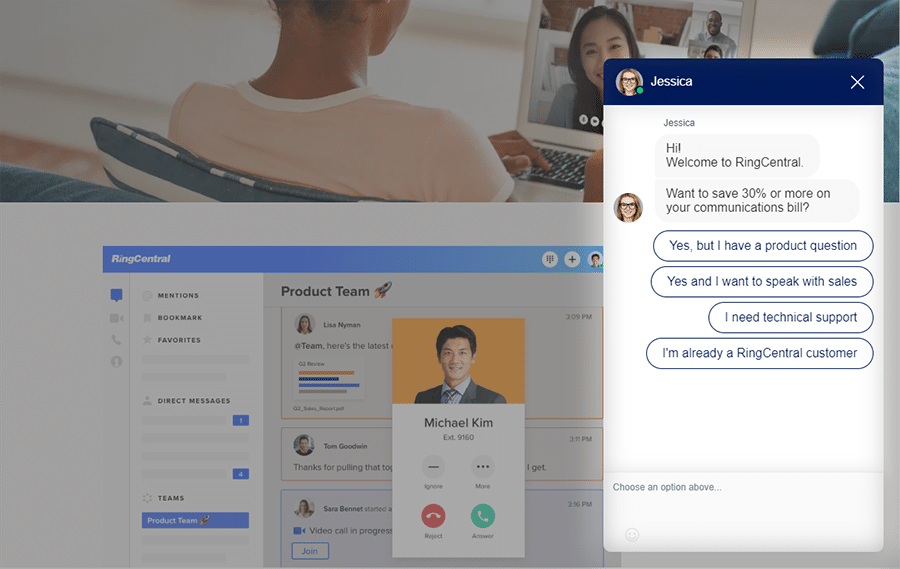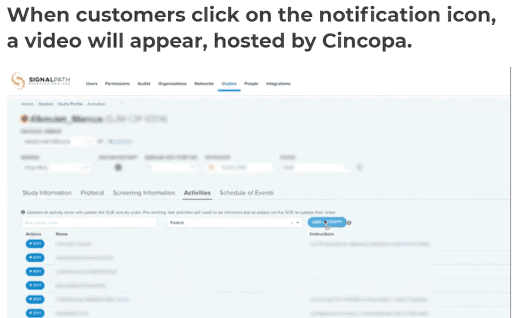There has been an arms race brewing for a while now; it is felt across all industries, and defines much of the way many companies conduct their business.
And, it all revolves around customer support.
Who can provide the most comprehensive yet eye-level, immediate yet high-quality customer experience?
More often than not, organisations that fit that bill are simply more successful.
However, a rapidly evolving consumer landscape calls for a creative outlook towards customer experience.
An omnichannel approach is, therefore, in need; one that will leverage existing tools, such as text-based information and chatbots while offering customers a more dynamic experience.
Video is more than up for the task.

The rise of video in customer service – Background
Video’s indelible imprint on business is readily apparent in every aspect of a modern company.
Contemporary marketing is essentially defined by video:An overwhelming number of marketers leverage video-based tactics and solutions, yielding favourable results
According to most indications, the success of a modern sales person hinges on his or her ability to capitalise on cutting-edge, personalised video platforms and approaches.
Video emerging as a dominant force within customer support is arguably far more interesting.
Reacting to the soaring rise in YouTube ‘how to’ videos and tutorials, most modern companies understand the vital importance of video geared towards ensuring customer satisfaction and retention.
However, video’s true value-add to customer service is rooted in its ability to inject it with a much-needed personal, human element. This is most apparent in customer success’ elevated importance within the world of SaaS.
Offering services and products that are often complex and intricate (not to mention costly…), SaaS platforms understand that ensuring customer retention entails long-standing, personal relationships. Finally receiving widespread public acclaim (regardless of the unfortunate circumstances that have led to it), video conferencing platforms have been instrumental in enabling customer success personnel to offer continuous, higher-quality service.
There’s no getting around it:
Some messages cannot be properly conveyed using email or traditional phone calls.
The need to visually demonstrate concepts, product updates and/or troubleshoot is at the heart of customer success’ ascension to the top of the B2B mountain, along with the demand for personalised service.
Being able to leverage the unique visual elements of video leads to higher levels of customer comprehension and is instrumental in crafting more efficient customer complaint tickets.
Lastly, companies using powerful video conferencing solutions can rest assured, knowing that all video sessions are recorded.
That way, if a customer success agent offers a unique solution, it can be examined, and, ultimately, leveraged by his or her teammates, as well.
5 ways in which video can provide a dynamic customer experience:
‘That’s great, but what if my company isn’t SaaS and/or doesn’t have a customer success department?’, you may be asking.
Fret not.
Video can be easily woven into even those companies with bare-bones customer service apparatus.
And, most importantly, it can be done without costing an arm and a leg.
Without further ado, here are 5 approaches you can begin exploring right away:
1. Dynamic, short-formatted video FAQ sections
‘Frequently asked questions’ sections have been website staples since, well, forever.
Concise and to the point, they function as websites’ ‘first responders’. FAQ sections typically provide basic information regarding the service or product offered by the company or platform:
‘How much will it cost? How do I start using it? Why am I having trouble performing a certain task?’ Those are just some of the issues addressed within FAQ pages.
At times, however, FAQ sections can come off as a copout of sorts; similar to the way food products are presented with facts regarding their nutritional value. If presented incorrectly, readers may come away feeling that the website is presenting information because they have to. It may have been published innocuously, but a FAQ section can sometimes fail to convey its primary objective to visitors:
It is there to help them.
Think of incorporating bite-sized videos to these sections.
The benefits are two-fold:
You’ll be adding a much-needed human touch along with presenting important information in a way with which visitors are more likely to engage.
Most importantly, all of this can be done for free. With free Chrome extensions, you can record yourself and your screen, and easily demonstrate any and all concepts relating to your service or product.
It’s important to note that this approach doesn’t have to replace text-based FAQs outright. Rather, it can complement the traditional method.
There are undeniable SEO benefits that come with having a written FAQ section.
Good video hosting platforms, such as Cincopa, offer dynamic templates through which you can present bite-sized video side-by-side with the typically-concise FAQ and answers.

2. Embedding video within chatbots
AI has revolutionised web-based customer support.
With powerful solutions, such as RingCentral’s numerous chatbot apps, sophisticated automation is primed to reign supreme over the world of web-based customer support.
In the UK, 80% of all businesses will have a chatbot solution in place by the end of 2020.
Thanks to an influx of new platforms and solutions, chatbots’ spike in popularity is understandable.
When engaged with, chatbots can greatly assist website visitors; either by curating relevant information, or by directing them to other areas of the website.
Why not bring video into the fold?
Discerning that a visitor would be best-served by being presented a short product demo, a bot can summon it. The videos will be embedded within the chatbot itself. Once clicked on, the visitor can be directed to a designated video channel within the site, similar to how in-email videos work.
Better yet, the chat can expand, and the video can appear in its proper dimensions within the chat itself. This can be achieved by embedding YouTube links, or by using a video hosting and management platform. The former may be financially free, but it still comes with a cost.
Even when extensively customised, YouTube video players can see your visitors easily bouncing out to YouTube’s main site. Additionally, they will probably be recommended content similar to that with which they’re engaging. More than likely, that content will either subtly or (in most cases) directly promote your competitors. With video hosting platforms, you ensure that all video interactions remain in-house, with you exclusively dictating the manner in which the videos are presented.
The second option enables you to leverage site visitors’ video engagement towards future marketing initiatives, as well. With good video hosts integrating with marketing automation platforms, you can see to it that those who interact favorably with the videos presented to them via chatbots are then sent further, related content; be it email, blogs or additional videos.

3. Video within live-chatsThe yin to chatbots’ yang, live-chats are heavily leaned on by service providers, especially within the tech sphere. More cost-effective than a call centre, live-chats fit seamlessly into a world dominated by IM and collaboration apps.
However, as mentioned above, relying solely on text-based service solutions has its limitations. Very often, the problem or issue broached by a site visitor cannot be sufficiently addressed via text. Subsequently, the service provider will offer to schedule a call with the visitor. Yet, even that more advanced approach may prove limiting. The lack of a visual element will always place a cap on the level and quality of the provided service.
That’s why video is so critical in this case.
Instead of scheduling a call, service providers can leverage the aforementioned free Chrome extensions. Recording themselves, their screen, or both, they can easily demonstrate issues that would otherwise require a more lengthy back-and-forth via phone or text.
Additionally, this approach can help alleviate the tension brought on by service providers and service seekers being separated across different time-zones. Instead of struggling to find a window in which to conduct a phone call, service providers can leave detailed videos the moment they begin their shift.
4. Video-based product walkthroughs
A method popularised by companies such as Walkme and Pendo.io, digital adoption by ways of product walkthroughs has become increasingly pervasive. Initially adopted by more complex SaaS platforms, digital adoption apparatus can now be found on ecommerce sites, banking apps, and real estate and healthcare providers’ sites.
Intuitive yet sophisticated, the goal of these systems is simple:
To help those new to a platform or website acclimatise to it.
Visitors are encouraged to engage with arrows strategically positioned besides important sections of the website. Once clicked on, the arrows prompt the emergence of small text bubbles, containing concise tips and/or instructions pertaining to the functionality of the button or tab which the arrow points at.
There is a reason why so many companies plan on jumping aboard by developing and implementing a product adoption strategy.
Video can prove a difference maker here, as well.
Like with chatbots and livechat apparatus, good video platforms play nice with digital adoption solutions, too.
Integrating the two can result in short, instructional videos popping up once an arrow is clicked on. Site administrators can decide whether they want visitors to be presented with a video, a text bubble, or both. If they choose to, site admins can leave this up to the visitor’s choice, by letting the latter choose whether he or she prefers text or video instructions.
It’s important to stress that 4-5 second GIFs may prove the ultimate means through which to deliver information to a visitor. Combining the visual element unique to videos with the brief text messages typical to digital adoption platforms, GIFs are likely to resonate most strongly with new-comers to the site.
Similar to videos, these can be hosted on a video platform and synced with a digital adoption solution.
SignalPath, a medical app, uses Pendo.io in such a fashion, seeing considerable results in user comprehension and satisfaction.
Here’s a look at a video-based product walkthrough as seen within SignalPath’s app
5. Onboarding webinars
OK- this one is most relevant to SaaS platform providers. However, a post-COVID-19 world may soon see many other industries taking a page out of the technology software providers’ playbook.
Successful SaaS companies compare the customer life cycle to an iceberg. Converting a prospect into a customer is just the tip. With many platforms costing a pretty penny, retaining customers over lengthy periods is where the true money lies.
Oftentimes, customer success is brought into the fold even before the sales process is completed. More than just providing potential customers with much needed reassurance that they are going to be privy to a high-level of service, customer success is needed to help customers begin using the platform.
With many companies, particularly startups, lacking the manpower to dispatch personnel to every new or potential customer, a more scalable approach is deployed:
Onboarding webinars.
Often scheduled weekly or bi-monthly, onboarding webinars attract new and potential customers, offering them a direct, detailed look at the platform in question. Typically conducted by customer success professionals, these webinars are perfect for those with little to no prior knowledge of the software. Webinar hosts will often preface the session by explaining that they will be exploring the system in the way most new-comers do.
Next, they will present different pitfalls to avoid, and offer various ‘cheat codes’ that only those with intimate familiarity with the platform would know of. Solutions, such as RingCentral Webinar, come equipped with robust Q&A features. Enabling viewers to ask questions during and after the webinar can prove a big difference maker. Webinar hosts can prove their command of the platform, and ‘tease’ the level of care and courteousness customers can expect.

Key takeaways
Video has transformed every facet of industry, with customer support and service being no exception. Naturally lending itself to consumers’ desire for bite-size information, video can be used in a variety of dynamic ways throughout the customer lifecycle. Conversely, when more in-depth assistance is needed, video has shown to prove its weight in gold, yielding higher engagement and comprehension levels than text-based content. Finally, video solutions don’t necessarily have to supplant traditional approaches. Rather, they can complement each other, with video providing a much-needed visual stimulant.
About the author
Yoni Yampolsky is a marketing manager for Cincopa. A powerful digital asset management and hosting platform, Cincopa helps businesses untap their videos’ true conversion potential.
Originally published Jun 15, 2020, updated Jan 17, 2023

